Sam Spade
New Member
Hi all,
I'm a new member to the 420magazine forums, and a soon to be first-time grower. It is legal for me to grow in my state, but I'd still like to keep it stealth for when family or the cable guy comes by. After searching for months for the "perfect" piece of furniture on craigslist, I decided that in order to make the best use of my dedicated closet space I would have to custom build my own grow cabinet.
Using wood scraps from Ikea and some wood molding and tools I purchased from Home Depot, I've finished the cabinet frame. I didn't have any plans; I mainly "winged it" based on the space and materials I had. The frame as it is constructed will give me 26" of width and 22" of depth, yielding about 4 square feet of horizontal space which I plan to use for a scrog, with one or two plants. Inside the cab I have about 57" of vertical space from the top of the floor to the bottom of the top support beam. I plan on using between ten and fourteen 42-watt CFLs, yielding about 7,000-10,000 lumens per square foot. (For a small stealth grow, I'm not sure HPS is appropriate, and besides, I don't want to deal with problems related to high temperatures.) I also plan on doing a "Tulip"-style deep water culture setup [Deep Water Culture Tutorial, SH Kit & DIY]].
Now, some pictures, if I can get them to work.
Wood materials:
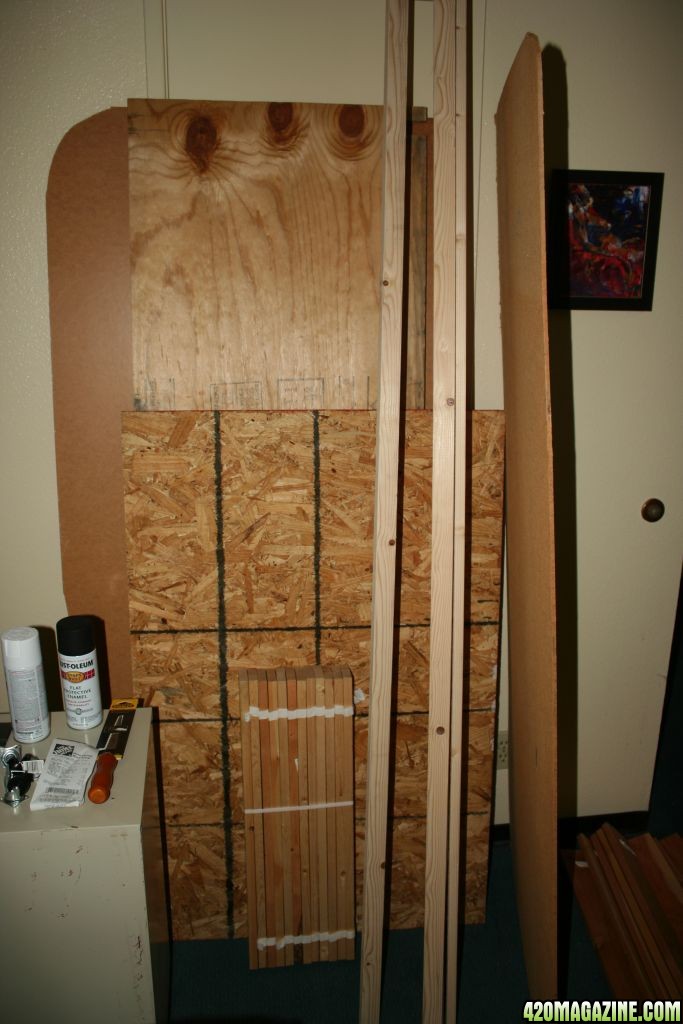
Floor and part of frame:
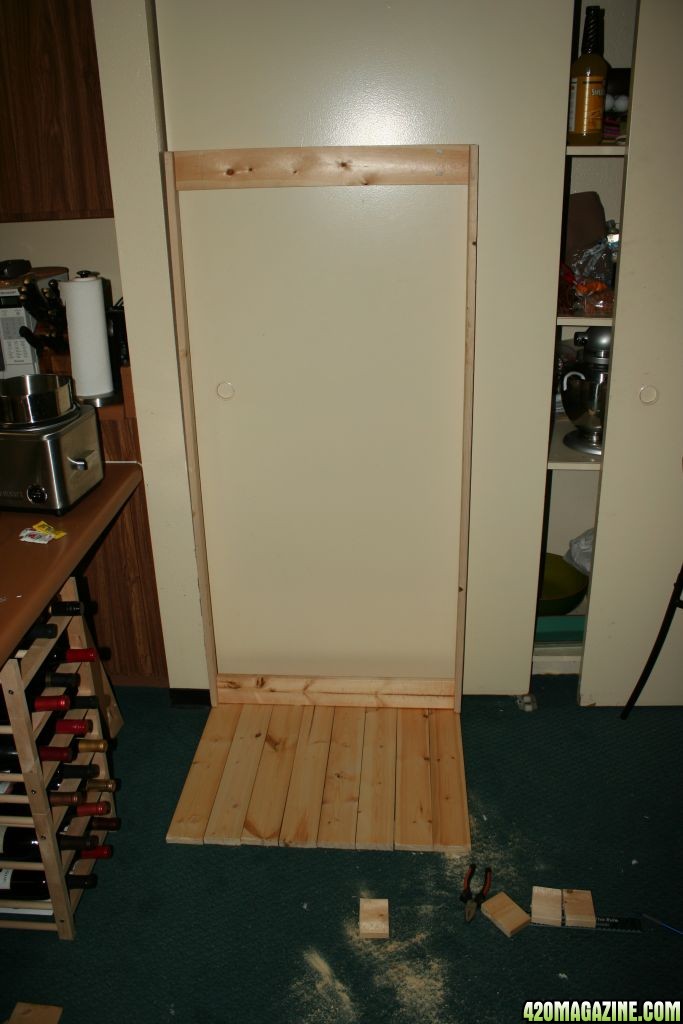
Frame takes shape:
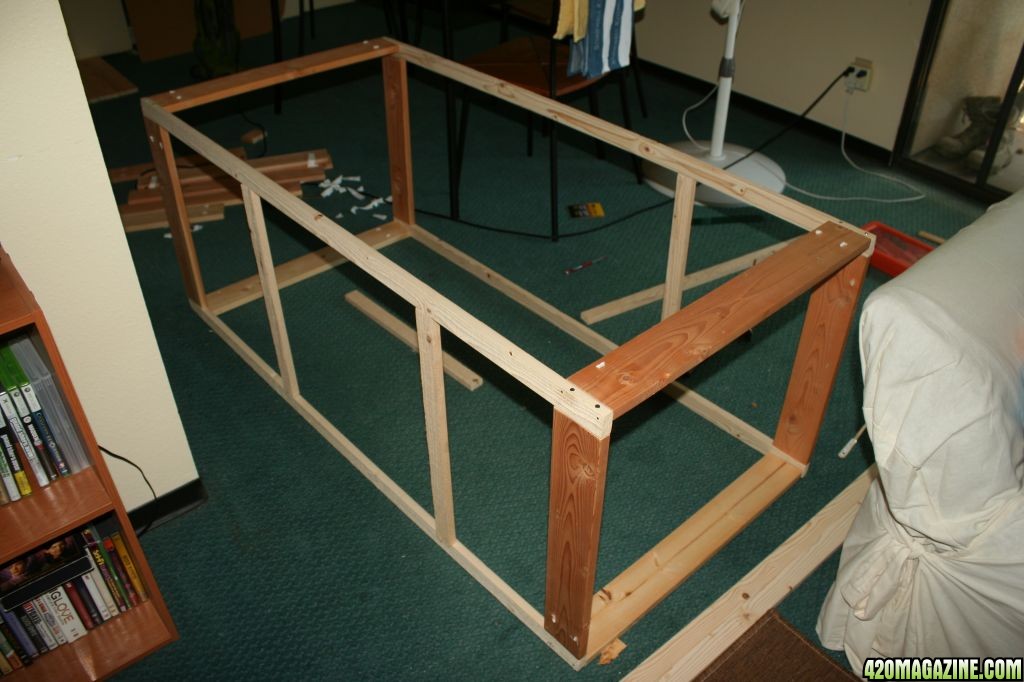
Frame connected to the floor:
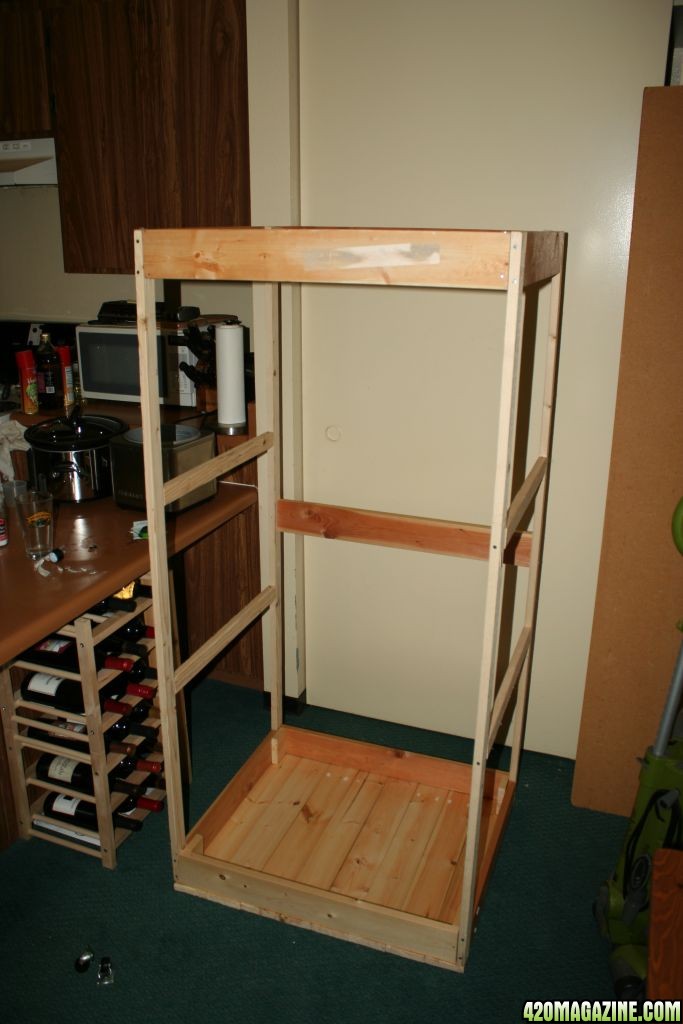
Cab fits nicely in the closet:
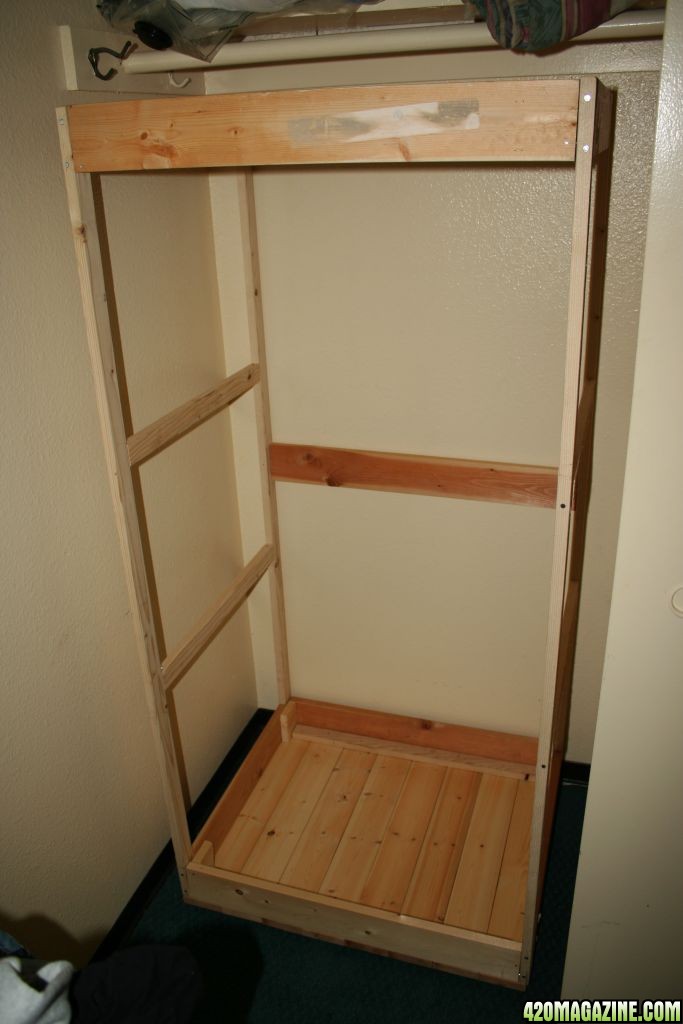
A view of the top support beam:
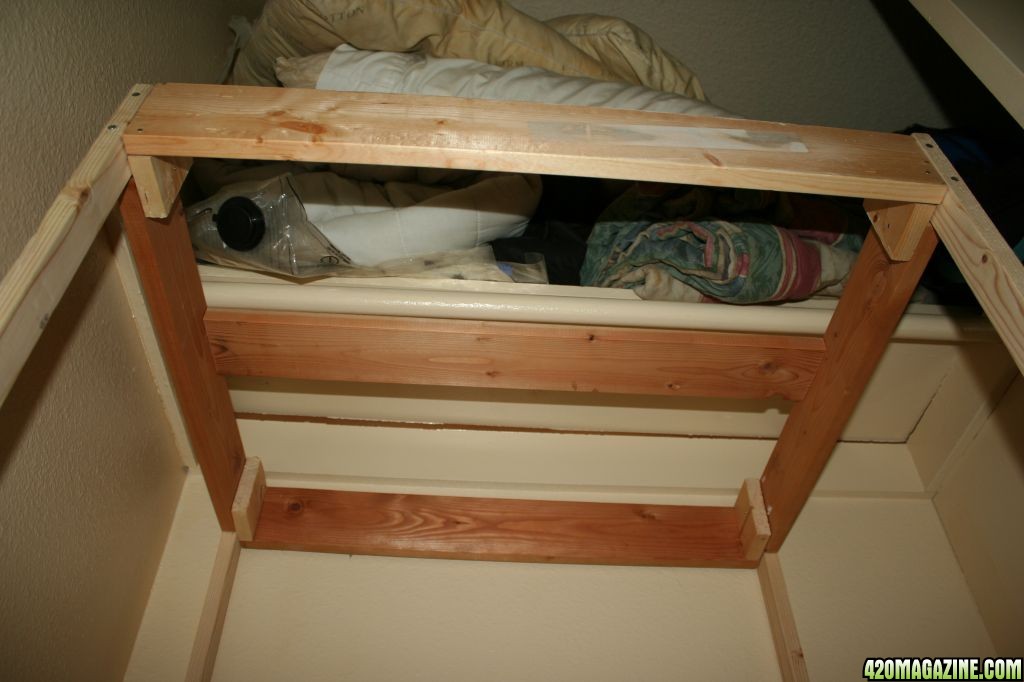
I think I'll use hardboard and/or a combination of poster board and hardboard to complete three of the walls. I'll have to cut holes in these walls for my exhaust vent, fitted with a carbon filter (somewhere near the top and back), and my passive intake vents (which will be somewhere near the front and bottom of the cab). The finished product doesn't have to be very pretty on the outside, because I don't expect unfriendlies to open this closet.
I'm not sure how I'll design the door yet. I might use piano hinges, or I might just strap it to the front with big pieces of velcro. Ideally, I would like the cabinet to be light tight, mostly to help that will help contain odors during flowering.
At this stage, I'm really looking for advice on the following points:
-What is the best way to grow hydroponically, while doing a screen of green? I'd like to imitate Tulip's deep water culture setup, but I'm worried about how I might change the water without disturbing the branches that are intertwined into the scrog screen. Perhaps I can have a second pump sit in the reservoir that is hooked up to a dedicated exit flow hose, that I will only turn on when it's time to empty the old water. Or maybe I can just rig up a $10 hand pump siphon. Ebb and flow might allow for an easier water change than deep water culture, because I would only have to disturb the lower reservoir (instead of messing with a tank list sitting just below the scrog screen), but is 57" enough space for that, after adding in the lights, screen, etc? And wouldn't the upper and lower reservoir still have to be connected by the drainage system, thus making the clean and easy removal of the lower reservoir also difficult? Heck, maybe I should just grow in soil for my first grow, since I'm very committed to the scrog part of the plan.
-I'm going with CFL bulbs because of their stealth, ease of use, ability to be laid out horizontally over a scrog screen. Besides, this grow isn't commercial, with a target of twelve ounces of dried product each year, or maybe six ounces per grow cycle. I don't want to have to worry about solving temperature problems or creating fire hazards -- I have enough worries as it is. For their high lumen/watt ratio and size, I've settled on the 42-watt CFL bulbs. But how many 42-watt CFL bulbs should I use? Each creates about 2,800 lumens. I'm thinking of going with 14 bulbs for a total of almost 10,000 lumens/sqft, although if I'm doing my math correctly, running fourteen bulbs 18 hours a day would add about $35 to my monthly power bill (yikes). Ten bulbs would generate a respectable 7,000 lumens, and $26.24 in monthly power costs. But will heat be an issue when running so many (10 to 14) CFL bulbs?
-Is it beneficial to have some warm (2700k) bulbs during vegging, or should I go all 6500k? If I can mix and match during both the veg and flower cycles I don't have to invest in so many bulbs up front. E.g., I could run, say, a 12-bulb system with 9 bulbs @6500k and 3 bulbs @2700k during the veg period, switching to 3 bulbs @6500k and 9 bulbs @2700k during the flower period. That would allow me a 12 bulb (total of 34k lumens) system while only have to buy 18 bulbs (9@6500k and 9@2700k) up front.
I'll be purchasing bulbs within the next week. The bulb/heat profile will dictate the cooling system and thus the wall and fan design, which will go in place after the lighting system. Then I'll buy whatever parts I need for the growing medium I choose (hydro or even soil).
Out of all the growing forums, 420magazine seems to be THE place for intelligent, helpful, and friendly advice. Any wisdom you can provide is deeply appreciated!
Sam
I'm a new member to the 420magazine forums, and a soon to be first-time grower. It is legal for me to grow in my state, but I'd still like to keep it stealth for when family or the cable guy comes by. After searching for months for the "perfect" piece of furniture on craigslist, I decided that in order to make the best use of my dedicated closet space I would have to custom build my own grow cabinet.
Using wood scraps from Ikea and some wood molding and tools I purchased from Home Depot, I've finished the cabinet frame. I didn't have any plans; I mainly "winged it" based on the space and materials I had. The frame as it is constructed will give me 26" of width and 22" of depth, yielding about 4 square feet of horizontal space which I plan to use for a scrog, with one or two plants. Inside the cab I have about 57" of vertical space from the top of the floor to the bottom of the top support beam. I plan on using between ten and fourteen 42-watt CFLs, yielding about 7,000-10,000 lumens per square foot. (For a small stealth grow, I'm not sure HPS is appropriate, and besides, I don't want to deal with problems related to high temperatures.) I also plan on doing a "Tulip"-style deep water culture setup [Deep Water Culture Tutorial, SH Kit & DIY]].
Now, some pictures, if I can get them to work.
Wood materials:
Floor and part of frame:
Frame takes shape:
Frame connected to the floor:
Cab fits nicely in the closet:
A view of the top support beam:
I think I'll use hardboard and/or a combination of poster board and hardboard to complete three of the walls. I'll have to cut holes in these walls for my exhaust vent, fitted with a carbon filter (somewhere near the top and back), and my passive intake vents (which will be somewhere near the front and bottom of the cab). The finished product doesn't have to be very pretty on the outside, because I don't expect unfriendlies to open this closet.
I'm not sure how I'll design the door yet. I might use piano hinges, or I might just strap it to the front with big pieces of velcro. Ideally, I would like the cabinet to be light tight, mostly to help that will help contain odors during flowering.
At this stage, I'm really looking for advice on the following points:
-What is the best way to grow hydroponically, while doing a screen of green? I'd like to imitate Tulip's deep water culture setup, but I'm worried about how I might change the water without disturbing the branches that are intertwined into the scrog screen. Perhaps I can have a second pump sit in the reservoir that is hooked up to a dedicated exit flow hose, that I will only turn on when it's time to empty the old water. Or maybe I can just rig up a $10 hand pump siphon. Ebb and flow might allow for an easier water change than deep water culture, because I would only have to disturb the lower reservoir (instead of messing with a tank list sitting just below the scrog screen), but is 57" enough space for that, after adding in the lights, screen, etc? And wouldn't the upper and lower reservoir still have to be connected by the drainage system, thus making the clean and easy removal of the lower reservoir also difficult? Heck, maybe I should just grow in soil for my first grow, since I'm very committed to the scrog part of the plan.
-I'm going with CFL bulbs because of their stealth, ease of use, ability to be laid out horizontally over a scrog screen. Besides, this grow isn't commercial, with a target of twelve ounces of dried product each year, or maybe six ounces per grow cycle. I don't want to have to worry about solving temperature problems or creating fire hazards -- I have enough worries as it is. For their high lumen/watt ratio and size, I've settled on the 42-watt CFL bulbs. But how many 42-watt CFL bulbs should I use? Each creates about 2,800 lumens. I'm thinking of going with 14 bulbs for a total of almost 10,000 lumens/sqft, although if I'm doing my math correctly, running fourteen bulbs 18 hours a day would add about $35 to my monthly power bill (yikes). Ten bulbs would generate a respectable 7,000 lumens, and $26.24 in monthly power costs. But will heat be an issue when running so many (10 to 14) CFL bulbs?
-Is it beneficial to have some warm (2700k) bulbs during vegging, or should I go all 6500k? If I can mix and match during both the veg and flower cycles I don't have to invest in so many bulbs up front. E.g., I could run, say, a 12-bulb system with 9 bulbs @6500k and 3 bulbs @2700k during the veg period, switching to 3 bulbs @6500k and 9 bulbs @2700k during the flower period. That would allow me a 12 bulb (total of 34k lumens) system while only have to buy 18 bulbs (9@6500k and 9@2700k) up front.
I'll be purchasing bulbs within the next week. The bulb/heat profile will dictate the cooling system and thus the wall and fan design, which will go in place after the lighting system. Then I'll buy whatever parts I need for the growing medium I choose (hydro or even soil).
Out of all the growing forums, 420magazine seems to be THE place for intelligent, helpful, and friendly advice. Any wisdom you can provide is deeply appreciated!
Sam



 .
. I don't know how long this sale lasts though.
I don't know how long this sale lasts though. ). In the future I can upgrade to an air-cooled reflector and either give the cheap one away to someone that needs it or use it with for a vegetative reflector.
). In the future I can upgrade to an air-cooled reflector and either give the cheap one away to someone that needs it or use it with for a vegetative reflector. .
.